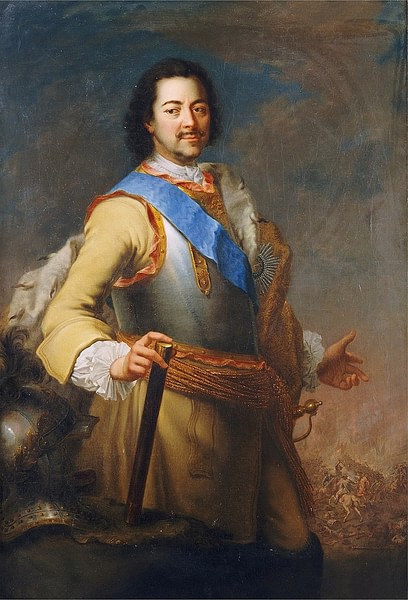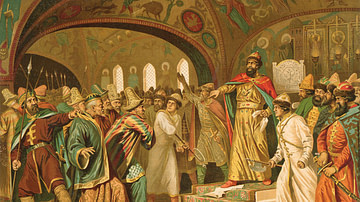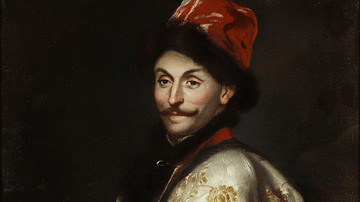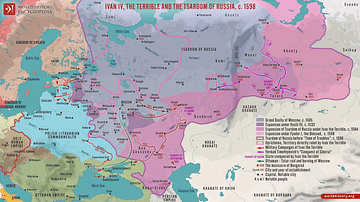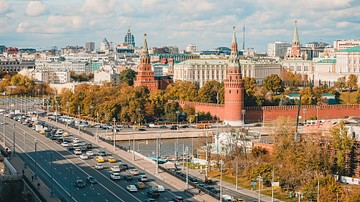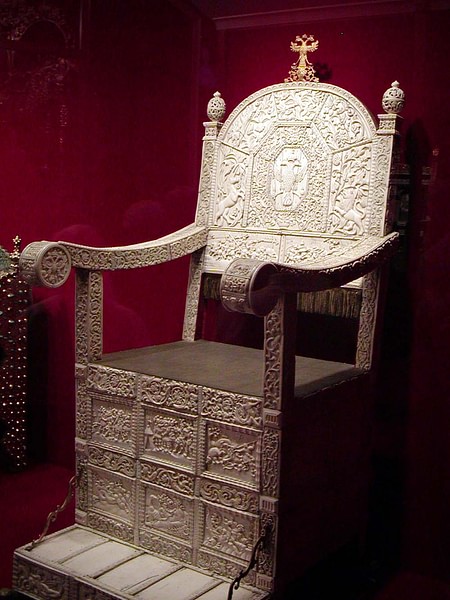
Tsar (also czar) is a Slavic term derived from the Latin caesar. Ivan III (Ivan the Great) (r. 1462-1505) was the first Russian ruler to begin using the title of tsar during his reign instead of the title Grand Prince of Moscow. His grandson, Ivan IV (Ivan the Terrible) (r. 1547-1584), was the first Russian ruler formally crowned as tsar.
At the time, the title did not mean absolute power but referred to a ruler who did not have to pay allegiance to a foreign sovereign. The early Russian tsars claimed they were descended from the Roman and Byzantine emperors to justify further their right to rule. The Patriarch of Constantinople confirmed the title of tsar in a formal document in 1561. He compared Ivan IV to a Byzantine emperor, stating that he was sovereign of all Orthodox Christians from the East to the West. The title 'tsar' was used in Russia from 1547 to 1721 when Russia became an empire and Peter the Great (r. 1682-1725) was crowned emperor.
Origin of the Title
The title tsar was initially used for the khans of the Golden Horde and the emperors of the Byzantine Empire. Tsar was used to distinguish between the pagan Roman emperors of the past and the Christian emperors of modern times. The female equivalent of tsar is tsarina (also called tsaritsa).
Ivan III (Ivan the Great) adopted the title of tsar during his reign, although he was never formally crowned as one. In those days, the tsar did not symbolise a ruler with absolute power but an independent sovereign who ruled over the lands that were listed in their full title. The grandson of Ivan III, Ivan IV, would later proclaim that the title of tsar was given by God and that any opposition was sacrilege.
The first tsars of Russia adopted mythological genealogies in an attempt to connect them to Imperial Rome. In a treatise called The Tale of the Vladimir Princes, Prus, a brother of Augustus, was included in the story. Prus was said to be a direct descendent of Rurik, the legendary Viking chieftain of the Kievan Rus. Ivan IV often referred to Augustus as his ancestor as a way to justify his sovereignty. The Great State Book was a collection of biographies of Russian princes and tsars, which also featured Augustus and Rurik as a way of showing the connection between those two great rulers and the Russian monarchs.
The tsars were eventually viewed as secular rulers who could achieve miraculous things, almost like a god on earth. Simeon Polotskii (l. 1629-1680), a monk from Kyiv, wrote a book called Sceptor of Rule in which he added individual characteristics to the title of tsar ("most pious"). These qualities were used in church and court, although they were not part of a tsar's formal title.
The Third Rome
Ivan III's second wife was Sophia Palaiologina (l. c. 1449-1503), the niece of the last Byzantine emperor, Constantine XI (r. 1449-1453). Ivan III had chosen her as a bride as a way to bring Byzantine grandeur to the Russian court. Sophia's influence on her husband would cause significant change in Russia over the next 400 years. Ivan III incorporated the Byzantine double-headed eagle into the Russian coat of arms at her suggestion. He also included certain Byzantine traditions into Russian ceremonies, including adopting more solemn, church-based coronations. During this time, he began signing his documents with 'tsar'.

Ivan III saw himself as the heir to the throne of the Eastern Roman Empire. He believed that Moscow was the 'third Rome', the successor to Rome and Constantinople as the capital of the Christian world. Three legends supported Moscow's claim as the 'third Rome'. The first legend was the belief that St. Andrew (d. c. 60) had brought Christianity to Russia; the second was the tsars' familial connection to the Roman and Byzantine emperors. The third legend established the Russian Orthodox Church as the successor to the Greek Orthodox Church. It revolved around the tale that Grand Prince Vladimir II Monomakh's (r. 1113-1125) grandfather, Byzantine Emperor Constantine IX Monomachus (r. 1042-1055), had offered Prince Vladimir joint rule of the Byzantine Empire and the Orthodox Church. What the legend fails to mention, however, is that Constantine IX died before Vladimir had even become prince, so there is no truth to this tale.
Coronation of the Tsars
The Legend of Monomakh also explained the splendour of the imperial Russian coronation and its regalia. According to the legend, Vladimir Monomakh received imperial regalia from his grandfather. Macarius, the Metropolitan (archbishop) of Moscow (l. 1482-1563), designed the first Imperial Russian coronation rite for the coronation of the 17-year-old Ivan IV in 1547. Unlike the French and English royal coronations, which featured medieval traditions like the Peers of the Realm and Rites of Chivalry, the Russian ceremony was one of absolutism, which was inspired by the Byzantine rites of the 14th century. The regalia, which included Monomakh's Cap (crown), a sceptre, and the cross and shoulder pieces (barmy), were evidence of a link to Byzantium.
The coronation began with Ivan IV asking Macarius to consecrate his hereditary links to the title of tsar. Macarius confirmed Ivan IV's right to the throne, then he placed the cross around Ivan IV's neck, put his hands on his head, and read the benediction. This completed the act of consecration. Ivan IV was crowned and held the orb and sceptre. For the final part of the coronation, Macarius read the precept: the tsar's obligations towards the Church and his subjects. The tsar's future death and rule in heaven alongside God and the saints was acknowledged as a reward for his piety towards God.
Anointment was added to the coronation ceremony in the 1550s, and this became part of the tradition in Russian imperial coronations from that point forward. In Russian coronations, the anointment took place after the investiture. It was done to signify that the tsar was the most holy of all men and the equal of all Western sovereigns. It, however, was not significant to the consecration of the tsar's secular power.
During his reign, Tsar Alexis of Russia (r. 1645-1676) introduced two new traditions into the coronation ceremony: the taking of the Holy Communion and the Creed being recited. These two additions ensured that the ceremony had even more in common with the coronations of Byzantine and European rulers. The coronations usually ended with a lavish banquet that further established the solidarity between church and state. The patriarch, or head of the church, welcomed the tsar into the sacred, religious space, while at the banquet, the tsar welcomed the patriarch into the Palace of Facets, a secular space.
Tsar of All the Russias
As more territories came under Russian control, Ivan IV began calling Russia 'Rossiia' instead of 'Rus', which only referred to the territories of the Muscovite Principality. During Tsar Alexis' reign in the 1650s and 1660s, the tsar used the title "tsar of all the Russias' after more land, including Kyiv, Smolensk and White Russia (modern-day Belarus), was seized by Russia. A new state seal was created by Lavrentii Khurulevich, a heraldry master from Austria. The new seal had an eagle with raised wings, imitating the Holy Roman Empire's seal. The eagle held an orb and sceptre in its talons, which stood for "the most gracious Sovereign, His Imperial Majesty, Autocrat and Possessor." Three crowns above the eagle represented Siberia, Kazan and Astrakhan, and three columns on the borders symbolised Great, White, and Little Russia.

Tsars & the Russian Orthodox Church
The Russian Orthodox Church played a considerable role in the life of every Russian, and the tsars were no exception. A tsar's power was dependent on their personal piety and morality. They were seen as defenders of the Orthodox Church. More importantly, the church was a fundamental feature of the autocratic state, and the ministers of the church obeyed the tsar. In return, most of the tsars respected the hierarchy of the church and protected it.
In 1589, under Feodor I of Russia's (r. 1584-1598) rule, a patriarch was elected. By placing a patriarch at the head of the Orthodox Church, it freed it from foreign supremacy. At the time, the Russian Empire was the only Orthodox state free from foreign sovereign interference, so it was only natural that the Russian Orthodox Church would want to follow in Russia's footsteps. The patriarch was in charge of ecclesiastical justice. He was financially supported by the large estates of the wealthy and from the revenue raised by the monasteries. Like the tsar, he had his own courts of justice and accounts and administrative offices. A patriarch was, for all intents and purposes, a tsar of the church.
Tsar Alexis strived to transform the Russian Orthodox Church into a universal church and form of Orthodoxy. The church underwent various reforms during the 17th century, including replacing the liturgy and books with Greek and Ukrainian versions, changing the liturgy, revising books, and replacing religious icons with new ones that showed the three-fingered cross. Tsar Alexis appointed Patriarch Nikon (l. 1605-1681) to oversee these reforms. Patriarch Nikon viewed himself as a co-tsar and persuaded Alexis to take part in strict liturgical routines, in which Alexis wore rich golden robes that resembled the robes of Byzantine emperors and carried an orb and sceptre that was made in Istanbul. During church services, he was addressed as sacred (sviatoi), which presented Alexis with the qualities of a demigod, going against the religious beliefs of the Russian Orthodox Church. Alexis was presented as the absolute monarch who had both secular and ecclesiastical preeminence.

Servitors (nobles who took part in military or religious ceremonies under threat of punishment) helped to support the tsar's role of pious ruler by joining in religious processions and services as the tsar's slaves. These religious processions would have been a sight to behold, with the tsar and his servitors being decked out in gold, emeralds, and pearls. In 1658, Alexis had a falling out with Nikon and exiled him from the Church, but he still upheld his reforms. Nikon's banishment from the Church proved that it was impossible for the church to take a stand against the tsar. On the other hand, the state had every right to interfere in church matters.
Alexis' son, Peter the Great, took things a bit further and abolished the role of the patriarch altogether, as he was wary of the power of the church and was aware of the obstacles that would arise when it came to the multiple reforms he wanted to put in place. Inspired by the various religious reformations in Western Europe, Peter I established an Ecclesiastical College (Holy Synod) in 1721, which comprised multiple colleges whose goal was to innovate the church further.
An Ecclesiastical Code was handed to each bishop, which warned them about becoming too prideful and reminded them that their roles were as subordinates and not on the same level as a tsar. The Holy Synod was seen as the hand of the tsar, an instrument in an autocratic state. However, the tsar must not be seen as the head of the Orthodox Church – only God was recognised in that role. Whatever power the tsar had over the Russian Orthodox Church, it was external and only relevant when it came to the church administration, not dogma or religious teachings. After being crowned by the church, the tsar becomes the highest representative of the Russian Orthodox Church and a Defender of the Church. He is appointed by God himself to rule over the believers of the Christin faith.
Tsars of Russia
The formally crowned tsars of Russia include:
- Ivan IV of Russia (Ivan the Terrible) (r. 1547-1584)
- Feodor I of Russia (r. 1584-1598)
- Boris Godunov (r. 1598-1605)
- Feodor II of Russia (r. 1605-1605)
- False Dmitry I of Russia (r. 1605-1606)
- Vasili IV of Russia (r. 1606-1610)
- Michael I of Russia (r. 1613-1645)
- Alexis of Russia (r. 1645-1676)
- Feodor III of Russia (r. 1676-1682)
- Ivan V of Russia (r. 1682-1696)
- Peter I of Russia (Peter the Great) (r. 1682-1721, as tsar)


